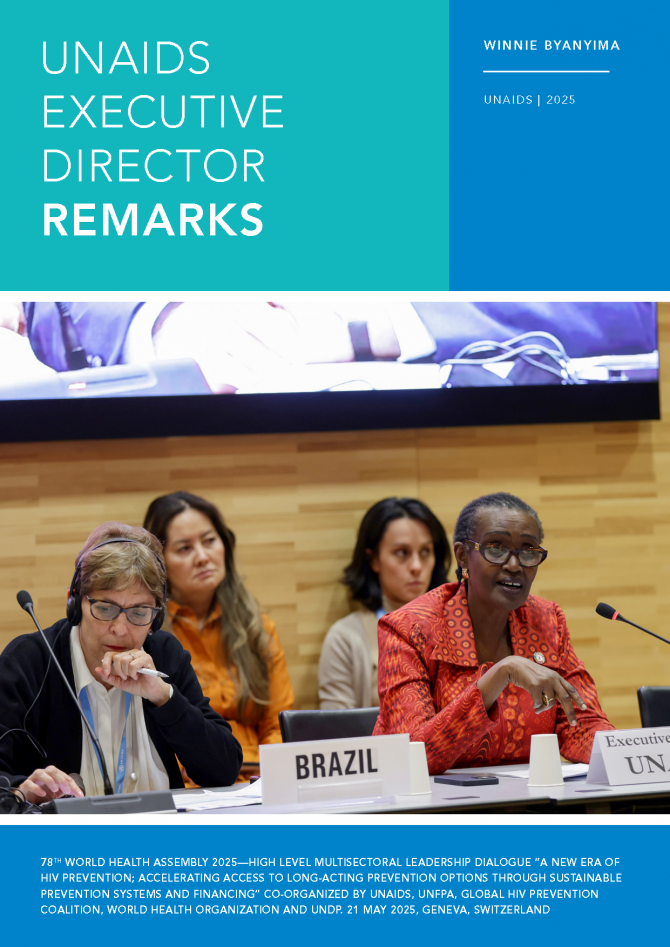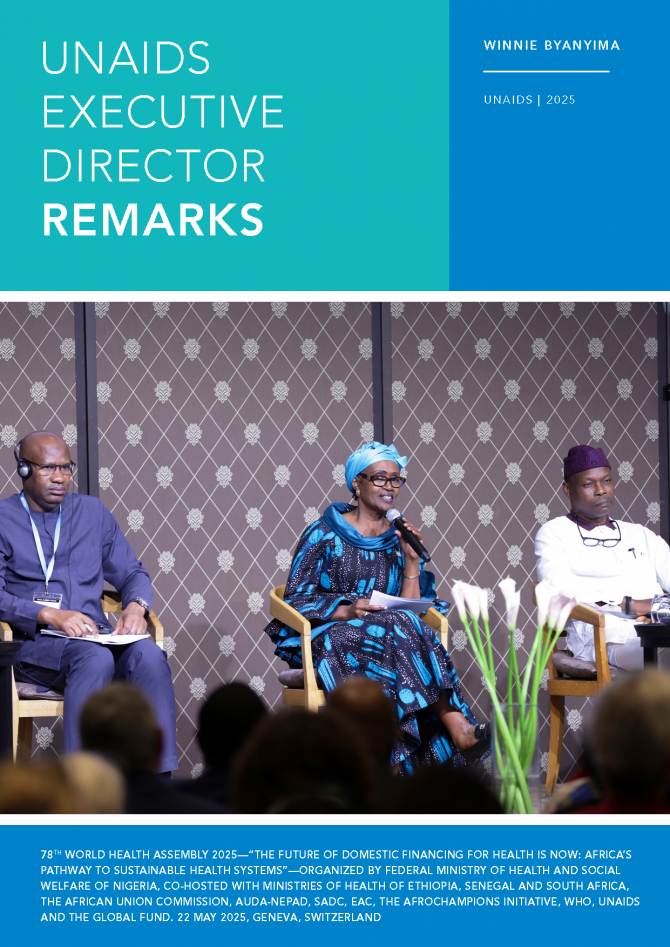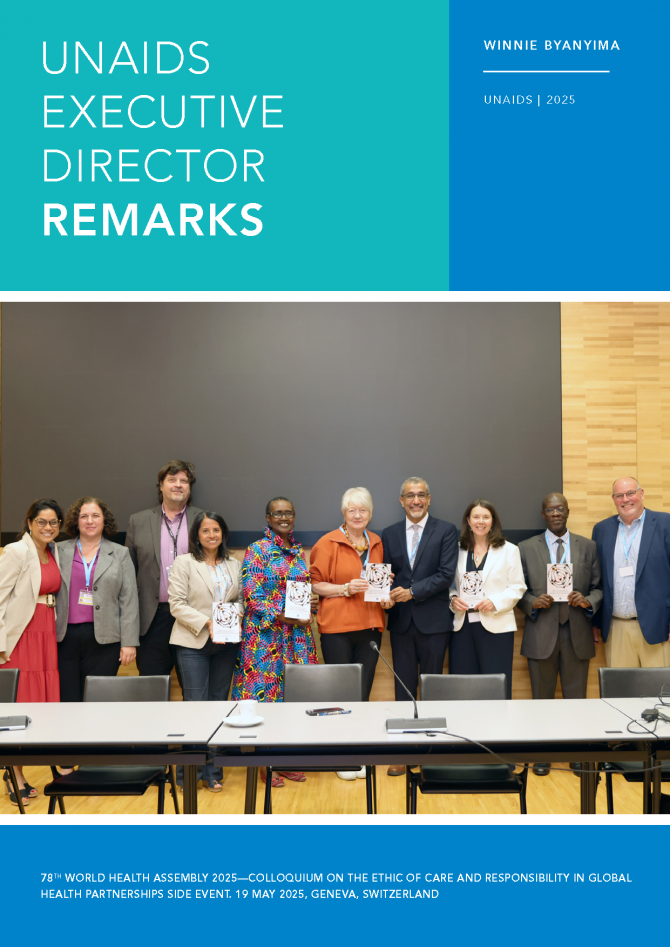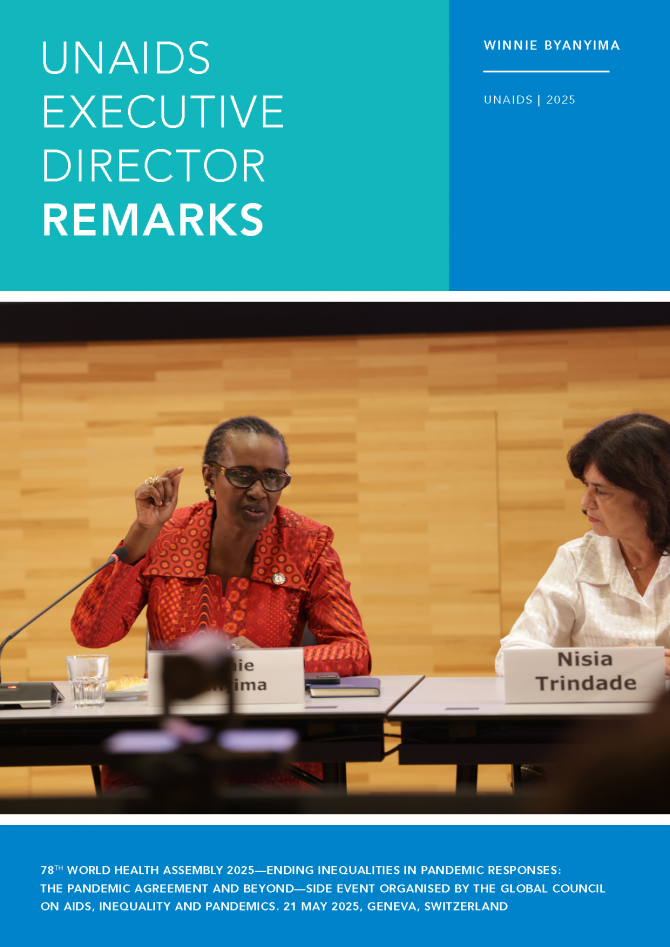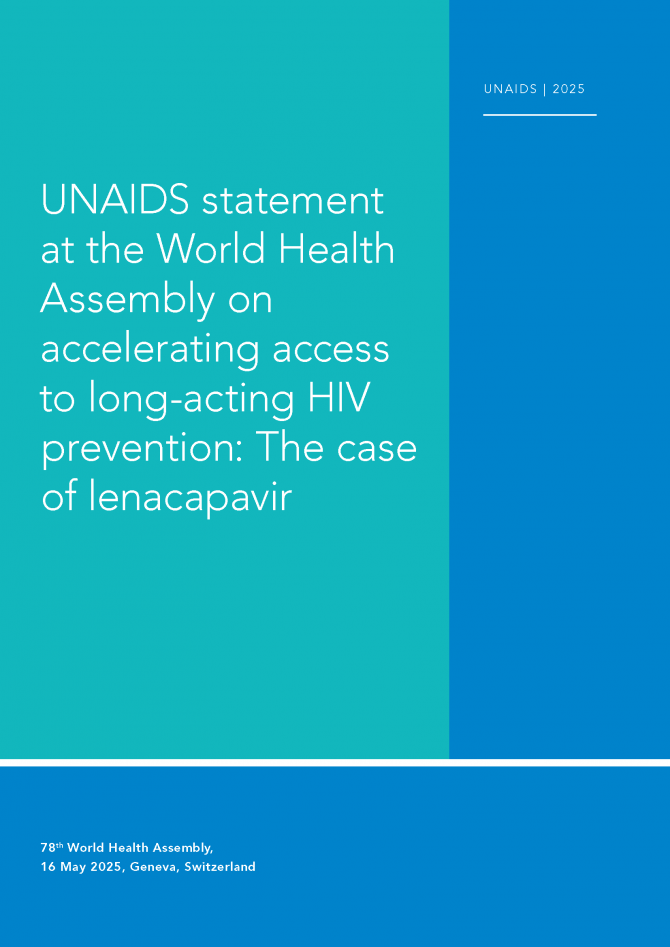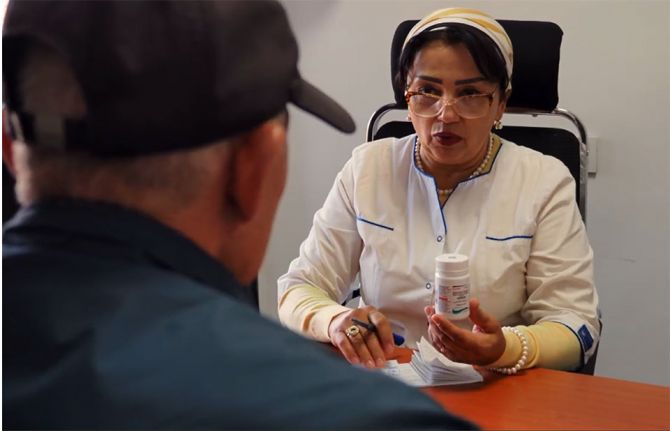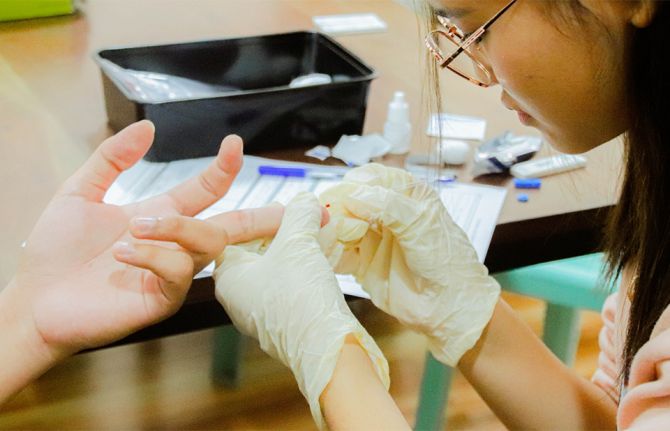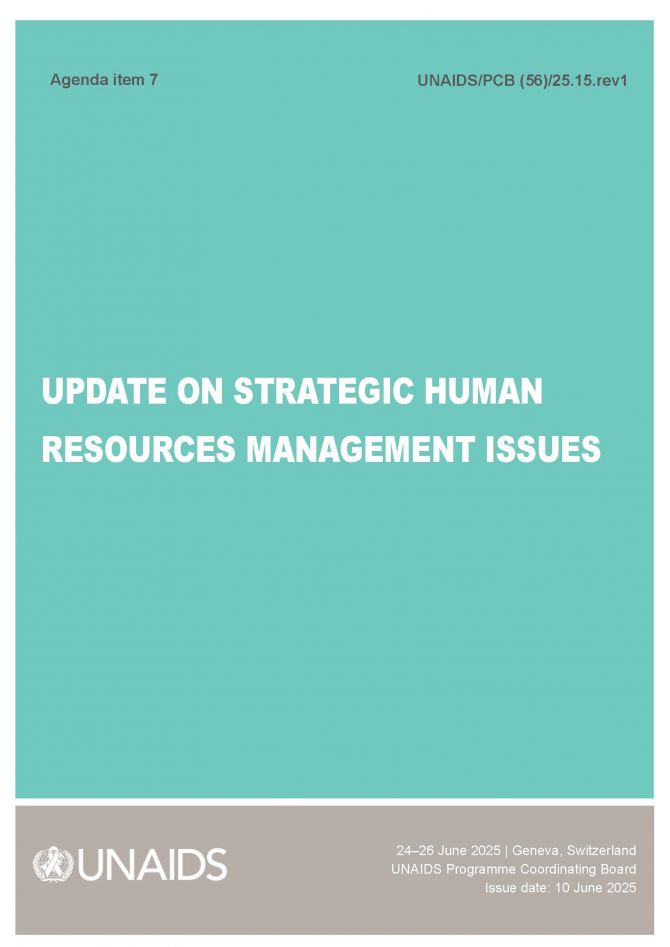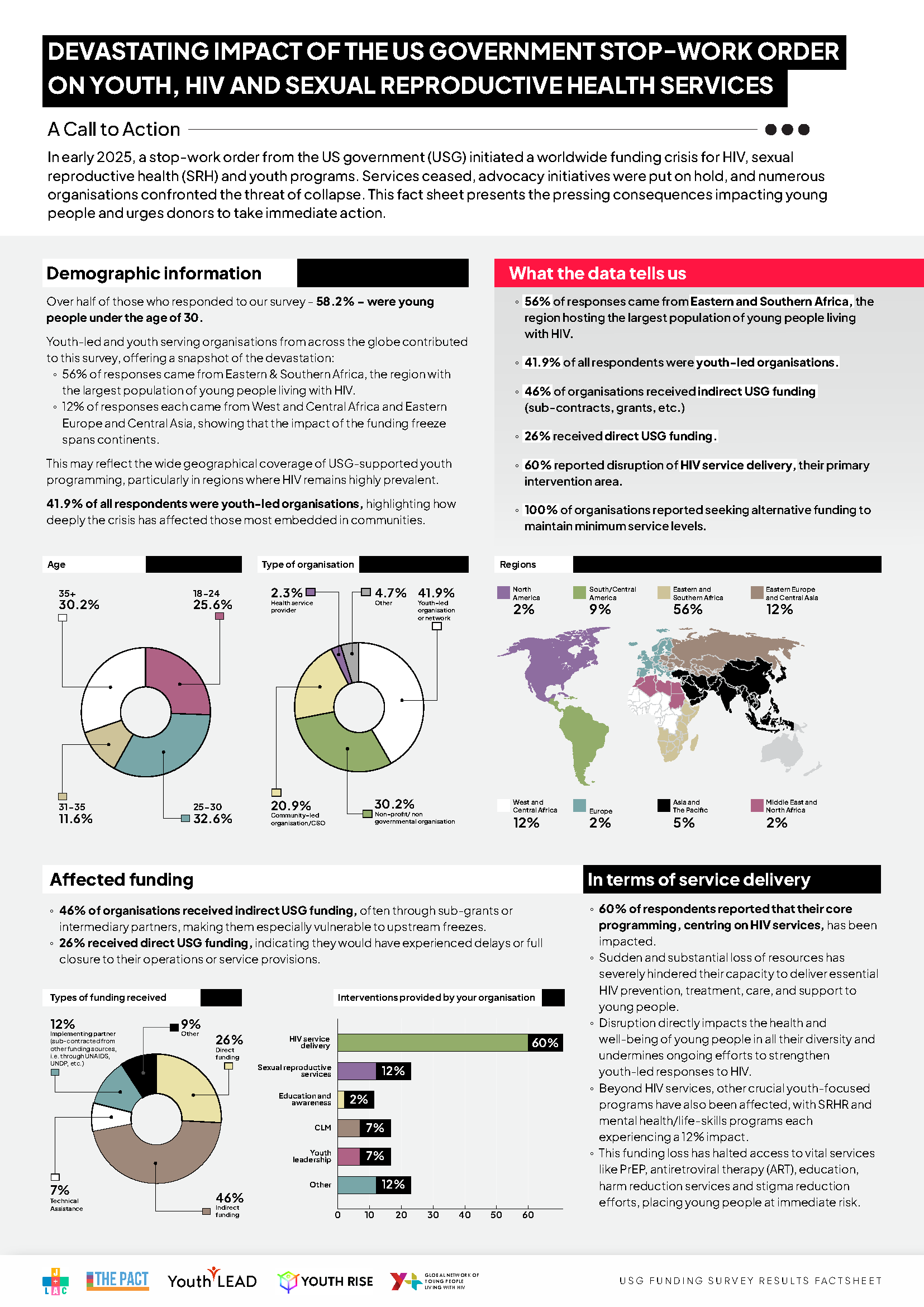Documents
A new era of HIV prevention; accelerating access to long-acting prevention options through sustainable prevention systems and financing
21 May 2025
UNAIDS Executive Director remarks - 78th World Health Assembly 2025 — High level multisectoral leadership dialogue “A new era of HIV prevention; accelerating access to long-acting prevention options through sustainable prevention systems and financing” co-organized by UNAIDS, UNFPA, Global HIV Prevention Coalition, World Health Organization and UNDP — Geneva, Switzerland, 21 May 2025
Documents
The future of domestic financing for health is now: Africa’s pathway to sustainable health systems
22 May 2025
UNAIDS Executive Director remarks - 78th World Health Assembly 2025 — The future of domestic financing for health is now: Africa’s pathway to sustainable health systems — Organized by Federal Ministry of Health and Social Welfare of Nigeria, co-hosted with Ministries of Health of Ethiopia, Senegal and South Africa, the African Union Commission, AUDA-NEPAD, SADC, EAC, the Afrochampions Initiative, WHO, UNAIDS and the Global Fund — Geneva, Switzerland, 22 May 2025
Documents
Ending Inequalities in Pandemic Responses: the Pandemic Agreement and Beyond
21 May 2025

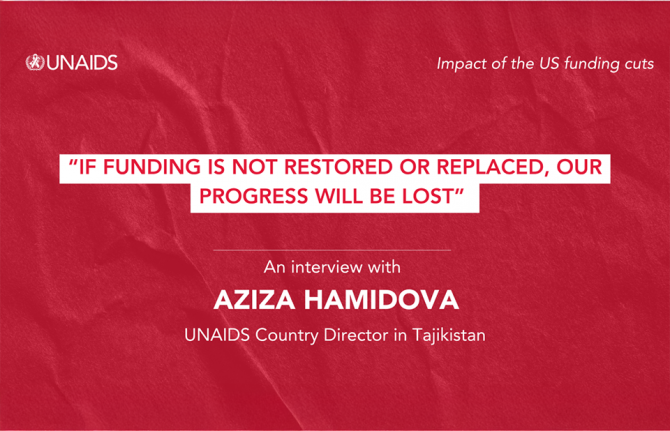
Feature Story
“If funding is not restored or replaced, our progress will be lost” - UNAIDS Country Director in Tajikistan amid funding cuts for the HIV response
29 May 2025
29 May 2025 29 May 2025As international funding declines, countries reliant on global support to fight HIV are being forced to adapt, and fast. In Tajikistan, the impact of these changes is already being felt. We spoke with Aziza Hamidova, UNAIDS Country Director in Tajikistan, about the country’s achievements over the years, the immediate impact of US funding cuts, and what is at stake for the most vulnerable communities.
Q: How would you describe the progress Tajikistan has made in its HIV response before the recent US funding cuts?
Tajikistan has made significant progress in its HIV response over recent years. Since 2020, HIV-related mortality has halved. Programmatic data on vertical transmission rates among women in care, suggests the rates have dropped from 2.6% in 2018 to just 0.8% in 2024, with only one case registered this year. Blood transfusion safety has been flawless for nearly 22 years, thanks to efforts by the Global Fund, UNAIDS, and other partners. Antiretroviral treatment costs have also been dramatically reduced—from US $254 to under US $65 per year—due to partnerships with PEPFAR, the Global Fund, and UNAIDS. Antiretroviral therapy is now available to all people living with HIV in the country. Outreach and awareness programmes, particularly for key populations such as people who inject drugs, men who have sex with men, sex workers, young people, and women living with HIV, have ensured good treatment coverage and testing rates. Pre-exposure prophylaxis (PrEP-medicine to prevent HIV) had also been available and promoted through civil society organizations. Importantly, community-led monitoring had become a critical, institutionalized part of the national HIV programme.
Q: What immediate impacts have the US funding cuts had on Tajikistan’s HIV response?
While the provision of basic HIV services, including testing and treatment at state healthcare facilities, has not been significantly affected—thanks mainly to Global Fund support—there have been notable reductions in outreach and access to services for key populations. PEPFAR’s investments have been crucial in improving the quality and reach of these services. As a result of the funding cuts, outreach, access to PrEP, testing, and counselling have all diminished. Two highly popular community health centres, known for providing stigma-free services, have closed, and community services for key population groups served by these centres have been completely stopped. Community-led monitoring, a vital mechanism for ensuring programme impact and accountability, has also been discontinued.
Q: What are you hearing from communities directly affected by these closures and service reductions?
Our partners and beneficiaries are reporting the suspension of awareness work, interruptions in comprehensive support programmes, and worsening mental health. We have observed a decreased adherence to antiretroviral therapy, particularly among clients who previously relied on community-led organizations or health centres. Many individuals who were on PrEP no longer feel safe or supported and have dropped out of the programme.
In addition, skilled professionals who provided these services have faced emotional burnout and job instability, with some leaving the sector altogether. Community-led organizations that lost funding for community-led monitoring are now unable to participate meaningfully in advocacy and policymaking or the implementation of the national HIV programme.
Although PEPFAR funding for community health centres and outreach was temporarily restored at the end of April, we are still seeing reduced rates of testing and client engagement, with a number of clients lost to follow-up.
Q: How have the government and partners responded to the funding cuts, and what is UNAIDS doing to support them?
Tajikistan never planned to remain dependent on external support indefinitely.
In 2024, with UNAIDS support, the country conducted a National AIDS Spending Assessment assessment, revealing that over 60% of the national HIV programme was funded externally, mainly by the Global Fund and the US government. In response, the government, with support from UNAIDS, PEPFAR, and the Global Fund, developed its first HIV Sustainability Roadmap, aiming for national programme sustainability by 2030. The abrupt funding interruption was a shock to all stakeholders, prompting emergency actions by the government. Strategic prioritization is now underway with the support of UNAIDS, and while additional state budget funding has been allocated for 2026, it remains insufficient. Mobilizing further external resources, especially for key populations, is still necessary.
Q: What would happen if US funding is not restored or replaced?
If US funding is not restored or replaced, Tajikistan would be set to lose about 60% of its HIV programme funding. This would risk the progress that we all worked so hard for, potentially returning the country to a time when access to testing and treatment was limited. Disruptions in prevention, testing, treatment, and care would occur, and gains achieved over years of dedicated work could quickly unravel. The most vulnerable populations would be at greatest risk, and the overall effectiveness of the national HIV response would be severely compromised.
Q: What message do you have for the international community?
The HIV response in Tajikistan, as in many countries, is a testament to the power of global solidarity and smart investments. Collective action by donors, governments, organizations, communities and civil society has saved millions of lives. Now, when we are so close to the 2030 goal of ending AIDS, this solidarity must not falter. Continued support is essential to preserve progress and prevent a reversal of the gains made.
The Joint United Nations Programme on HIV/AIDS (UNAIDS) leads the global effort to end AIDS as a public health threat by 2030 as part of the Sustainable Development Goals.
Following the US funding cuts in January, UNAIDS is working closely with governments and partners in affected countries to ensure that all people living with or affected by HIV continue to access life-saving services. For the latest updates, please visit unaids.org
Related resources
Watch: Humanity can do great things when united!
Watch: Funding cuts came as a complete shock, says Aziza Hamidova
Region/country

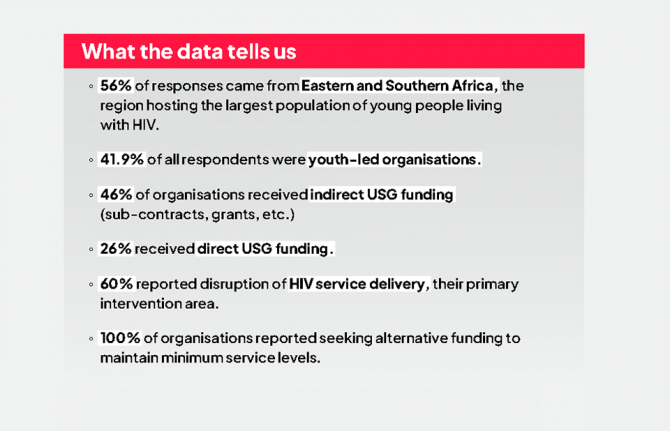
Feature Story
An urgent call to support youth-led organizations
28 May 2025
28 May 2025 28 May 2025The sudden stop-work order from the US government in early 2025 triggered a global funding crisis for HIV, sexual reproductive health (SRH), and youth programmes. This abrupt halt has left countless youth-led and youth-serving organizations struggling to survive, with devastating consequences for young people worldwide. The impact is profound, and the need for immediate action is critical.
A survey conducted by Y+ Global, Youth LEAD, Youth RISE, The PACT, and J+LAC in March 2025 among organizations delivering HIV and SRH youth programmes reveals the stark reality faced by youth-led and youth-serving organizations. Forty-five youth-led and youth-serving organizations from around the globe completed the survey, with 56% of responses coming from Eastern and Southern Africa, the region hosting the largest population of young people living with HIV. Sixty percent of respondents reported disruptions to their core HIV services, severely hindering their ability to provide essential HIV prevention, treatment, care, and support. These disruptions directly impact the health and well-being of young people in all their diversity and undermine ongoing efforts to strengthen youth-led HIV responses.
Beyond HIV services, other crucial youth-focused programmes have also been affected, with SRH, mental health, and life-skills education programmes each experiencing a 12% decrease. Furthermore, activities like youth-led advocacy and engagement in policy and decision-making discussions have also been impacted, leaving youth voices under represented and unheard in the HIV response as well as other development areas.
The survey also warns about the abrupt policy changes occurring as a consequence, including the integration of HIV-specific clinics into general health systems, and the surge of restrictive laws targeting organizations working on gender, diversity, and sexual and reproductive health and rights, using the term “foreign agent” to criminalize their work. These changes are causing the collapse of service delivery models and increased barriers to youth-led organizations, further reducing accessibility for young people.
“The funding cuts are not just numbers on a spreadsheet; they represent real lives, real services, and real hopes lost. Youth-led organizations are the lifeline for so many young people, especially those most at risk,” shared Maximina Jokonya, Executive Director of Y+ Global. “We need urgent action from donors and governments to recommit and reinvest in youth leadership and safeguard the future of the HIV response,” she added.
Despite these setbacks, youth-led organizations are showing incredible resilience by launching crowdfunding campaigns, seeking alternative national and international partnerships, and continuing peer outreach with limited resources. Still, the long-term sustainability of these efforts is threatened by the funding crisis.
Youth and the next Global AIDS Strategy
Amidst this crisis, UNAIDS convened two global youth consultations in the context of the Global AIDS Strategy 2026 - 2031 development process to gather young people’s views and priorities for the future of the HIV response. More than 120 young people from diverse young key and vulnerable population groups participated in this consultative process. The key messages resulting from these consultations are unequivocal: young people demand involvement in decision-making spaces of the HIV response and in the development of alternative funding strategies, such as the sustainability roadmaps. They also demand a leading role in the implementation and monitoring of these decisions, as well as the positioning of human rights, gender equality, mental health, and innovation at the centre of the HIV response.
Call to action
Youth-led organizations are making an urgent call to all donors, partners, and policymakers to act now to save youth-led responses by reinstituting traditional funding support, increasing domestic and emergency funding solutions to maintain the operational stability of youth-led organizations, and supporting youth leadership in the HIV response.


